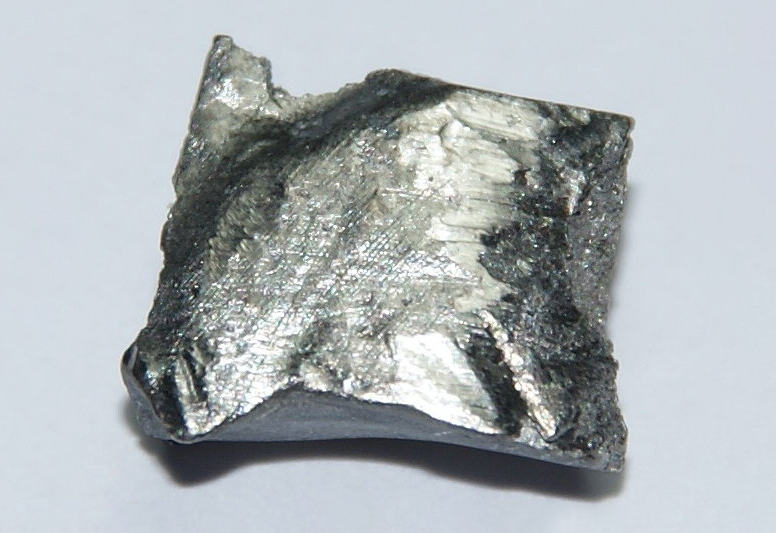
Terbium (Tb) is a soft, silvery-gray metal from the lanthanide group of rare earth elements. Like other lanthanides, terbium is ductile and malleable, meaning it can be easily shaped and drawn into wires. It is stable in air but slowly oxidizes over time. Though terbium is rare, its unique properties make it valuable in specific high-tech applications.
Terbium is a solid metal at room temperature with an atomic number of 65 and a density of 8.23 grams per cubic centimeter. It has a melting point of 1,356°C (2,473°F) and a boiling point of 3,123°C (5,653°F). These high melting and boiling points make terbium suitable for applications that involve heat. The metal can exist in two different crystal forms, transitioning between these forms at 1,289°C.

Chemically, terbium reacts slowly with cold water but more rapidly with hot water, forming terbium hydroxide and releasing hydrogen gas. When exposed to air, terbium gradually forms terbium oxide, which appears as a dark layer on its surface. Terbium also reacts with halogens like chlorine, bromine, and fluorine to form terbium halides, which are stable compounds.
Terbium has 26 known isotopes, but only one is stable. This stable isotope is 159Tb, which makes up all naturally occurring terbium. The other isotopes have shorter half-lives and are mainly used in scientific research. Terbium-159 is used in nuclear medicine and other specialized scientific applications.
Terbium does not occur as a free element in nature. It is found in small amounts in minerals like monazite, xenotime, and euxenite. These minerals contain various rare earth elements, including terbium, making extraction complex. Monazite, for example, contains about 0.03% terbium. Terbium is mainly mined in countries like China, the USA, Brazil, India, and Australia. The annual global production of terbium is about 10 tonnes, with total reserves estimated at around 300,000 tonnes.
To produce terbium metal, scientists reduce terbium fluoride or terbium chloride using calcium metal in an argon environment. This process is costly and difficult, contributing to terbium’s rarity and high price.
Despite its rarity, terbium has several important uses due to its unique properties.
Dopant in Solid-State Devices: Terbium is used as a dopant in solid-state devices. It is added to materials like calcium tungsten and strontium molybdate, used in electronics and semiconductors. Terbium is also used in high-temperature fuel cells, helping stabilize materials in extreme heat.
Magnets and Alloys: One notable use of terbium is in Terfenol-D, a special alloy that changes shape when exposed to a magnetic field. This property, called magnetostriction, makes Terfenol-D useful in sonar systems, sensors, and actuators. Terbium is also used in magnets for electric motors, including those in hybrid vehicles and wind turbines. These magnets must maintain their properties even at high temperatures, and terbium helps achieve this.
Green Phosphors in Lighting and Displays: Terbium is used to make green phosphors for fluorescent lamps and color television tubes. The bright green color produced by terbium compounds is essential in creating vivid displays on screens.
Counterfeit Prevention: Terbium is also used in anti-counterfeiting measures. In euro banknotes, terbium ions (Tb³⁺) emit a green fluorescence when exposed to ultraviolet (UV) light. This fluorescence helps verify the authenticity of currency and prevents counterfeiting.
Several terbium-related materials, including terbium oxide, Terfenol-D, terbium chloride, and terbium fluoride, offer specific advantages in technology, industry, and research.
Terbium Oxide (Tb₂O₃): Terbium oxide is one of the most widely used terbium compounds, primarily in the lighting and display industries. It is a key component in green phosphors, which are crucial for creating vibrant colors in television screens, computer monitors, and other displays. When combined with other phosphorescent materials, terbium oxide emits a bright green light, enhancing color quality and brightness. Additionally, terbium oxide is used in some high-efficiency lighting systems, such as fluorescent lamps, where its ability to produce green phosphorescence improves overall illumination quality.
Terfenol-D: Terfenol-D is a unique magnetostrictive alloy made of terbium, dysprosium, and iron. It can change shape in response to a magnetic field, a property known as magnetostriction. This material has applications in many fields, such as sonar systems, medical devices, and precision sensors. For example, in sonar technology, Terfenol-D helps convert electric signals into sound waves that can travel underwater, making it essential for naval and research applications. Terfenol-D is also used in actuators and transducers, where its precise movement capabilities improve performance in advanced mechanical systems. Terfenol-D’s ability to expand or contract based on magnetic fields makes it ideal for applications that require rapid, precise adjustments.
Terbium Chloride (TbCl₃): Terbium chloride is a versatile compound used in scientific research and the synthesis of other terbium-based materials. It is often used as a starting material for preparing terbium-based catalysts, which can accelerate chemical reactions in research settings. In the electronics industry, terbium chloride is used as a dopant in specialized materials, contributing to the development of high-efficiency semiconductors. Its application in electronics is particularly valuable, as terbium chloride enhances conductivity and thermal stability in devices. Terbium chloride is also studied for its fluorescence properties, which may lead to further applications in optoelectronic devices and imaging technologies.
Terbium Fluoride (TbF₃): Terbium fluoride is another important terbium compound, commonly used in solid-state devices and advanced optics. Its stability and resistance to moisture make terbium fluoride suitable for high-performance optical coatings, where it enhances durability and light transmission. Terbium fluoride’s reflective properties are also beneficial in specialized lenses and mirrors. Additionally, terbium fluoride is being explored as a potential material for laser technology, particularly in the development of green laser systems. This compound’s resilience against heat and corrosion enables it to perform well in devices that operate under extreme conditions.
Terbium Iodide (TbI₃): Terbium iodide is used in some specialty lighting and research applications. Its luminescent properties make it useful for specific types of lamps and display devices where high brightness and sharp color are required. Additionally, terbium iodide is of interest in the field of materials science, as it can act as a precursor for synthesizing other terbium-based compounds. Its high reactivity with certain chemicals also makes terbium iodide valuable for experiments in chemical synthesis and the development of new materials with unique properties.
Terbium has no known biological role in plants or animals. It is considered mildly toxic if ingested in large amounts, but its overall toxicity has not been studied in detail. Terbium compounds, especially in powder form, can irritate the skin and eyes if direct contact occurs. Because terbium is used in limited quantities, it does not pose a significant environmental risk.
Environmentally, terbium is generally harmless to plants, animals, and ecosystems. Its low abundance and limited use mean it is unlikely to cause environmental harm.
Terbium may be rare and costly, but its properties make it valuable in many advanced technologies. Its applications in solid-state devices, lighting, magnets, and anti-counterfeiting measures show its versatility. Along with terbium-related materials like terbium oxide and Terfenol-D, this metal plays a key role in specialized fields. Stanford Materials Corporation (SMC) is dedicated to providing high-quality terbium and other rare earth elements for research and industry. With a commitment to supporting innovation, SMC helps industries find new ways to use terbium in cutting-edge applications.
Eric Loewen
Eric Loewen graduated from the University of Illinois studying applied chemistry. His educational background gives him a broad base from which to approach many topics. He has been working with topics about advanced materials for over 5 years at Stanford Materials Corporation (SMC). His main purpose in writing these articles is to provide a free, yet quality resource for readers. He welcomes feedback on typos, errors, or differences in opinion that readers come across.

 Inquiry List
Inquiry List

